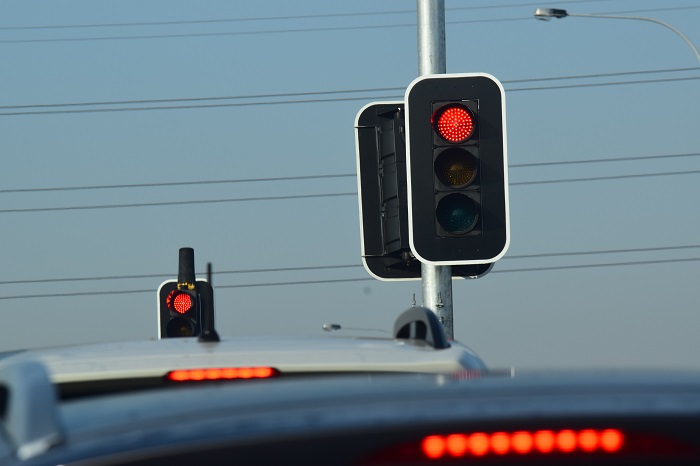PABLO GARCÍA-RUBIO | Tungsteno
Red, amber, green—a universal combination that regulates the coexistence of vehicles and pedestrians across the globe. Companies and researchers around the world are looking to AI-powered traffic lights as the key to ensuring smoother traffic flow and avoiding congestion. But what sequencing of these three colours can not only optimise mobility, but also reduce air pollution in a city?
In 2020, a trial was launched in the United Kingdom to reduce air pollution in cities by regulating traffic lights. The system, developed by the company Now Wireless, collects real-time traffic and city data, such as pollution levels and the weather. After analysing the conditions under which air pollution spikes occur at specific locations, it is able to predict up to an hour in advance where and when a spike will occur.
The traffic light network then acts accordingly: cars heading towards the pollution hotspot are held back for up to 20 seconds, while drivers travelling out of these zones can move more fluidly with longer green lights. The traffic manager of Wolverhampton, the city where the pilot test took place, specified that it was a way to reduce air pollution in the city centre and, in this way, avoid other measures carried out in other European cities that involve restricting vehicle access to city centres or imposing daily entry fees to discourage it.

Some traffic lights collect real-time traffic and city data to detect in advance where a pollution spike is going to occur. Credit: Unsplash.
Real solution or short-term measure?
However, are such schemes really effective in reducing emissions caused by traffic, or are they more of a gimmick to avoid pollution surges in specific locations by spreading emissions over a wider area to meet legal air quality obligations?
The president of the Automobile Association told The Times that: "Whilst well intentioned this technology could easily backfire by holding up traffic, prolonging idling and moving the problem elsewhere." Cars, vans, trucks and buses produce more than 70 % of the overall greenhouse gas emissions from transport, according to the European Environment Agency.
In Pittsburgh (USA), a technological solution for traffic light regulation has been in place for years. The initiative was developed by a team from Carnegie Mellon University in collaboration with the city council. The programme, called SURTRAC, uses cameras and radar to analyse traffic in real time and predict its movement.
Each intersection makes decisions autonomously and communicates with the rest of the traffic signal network to make the flow of moving cars more efficient. In this case, the aim was to reduce vehicle waiting times at traffic-light intersections and optimise traffic flow. While in 2016 it was operating at 50 of the busiest intersections in the city centre, today it regulates a third of the city's intersections.
Traffic congestion costs the US economy $121 billion, mostly due to lost productivity during the time drivers spend in vehicles, according to the project's developers. What’s more, this congestion produces 25 billion kilograms of potentially avoidable carbon dioxide emissions, the equivalent of the annual CO2 emissions from 4.5 million households.
The aim, therefore, would be to create a system capable of encouraging vehicles to spend as little time as possible on the road and, in the process, reduce congestion and idling. The pilot tests in Pittsburgh provided a revealing result: a smart traffic-management system in a city could reduce travel times by up to 25% and cut polluting emissions by up to 21%.
A programme called SURTRAC uses cameras and radar to analyse traffic in real time and predict its movement. Credit: Carnegie Mellon University.
Algorithms inspired by nature
A Spanish team of researchers from the University of Malaga, led by Enrique Alba, is also working on the development of smart models to regulate a city's traffic light network to improve mobility and reduce emissions. In this case, they use bio-inspired algorithms. In other words, they are inspired by the way in which elements in nature adapt in an evolutionary way to the environment. As Alba explains: "They do this with operations inspired by the evolution of species, such as the selection of the best sets of vectors, their cross-breeding and mutation so that the fittest survive, i.e. those that produce shorter times and less fuel consumption and pollution."
To improve mobility and reduce emissions, Alba believes that it is necessary to "take a holistic view of the city at all times and microanalyse it, considering each car, motorbike, pedestrian, bus... as much as possible." In this way, an accurate map of the city and its signalling can be created. In theory, the algorithm developed by this Spanish team can reduce travel times by more than 15%.
In addition, by taking the historical data and possible future changes to a city, the program is able to modify the signalling according to what is best for the city's traffic. Alba is unequivocal: it is a solution that is "comprehensive, cheap to implement—it does not involve extra or unnecessary hardware—and based on modern AI with a graphical interface."
All these projects show that smart traffic lights can play a key role in improving traffic flow and, consequently, in reducing emissions of polluting gases. But for such systems to work, air quality should not be the only variable to be taken into account. These technologies must also adapt to the challenges that come with the mobility issues of the future—from the growing fleet of electric vehicles to autonomous driving.
· — —
Tungsteno is a journalism laboratory to scan the essence of innovation. Devised by Materia Publicaciones Científicas for Sacyr’s blog.
